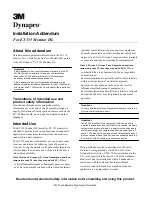
Appendix
RAID system
7
64
LDCDS-CPC9100 DE/EN 1.0
7.2
RAID system
A RAID system serves to organise several physical hard disks of a computer. The operation
of a RAID system requires at least two hard disks which are interconnected.
Possible advantages of a RAID system:
ƒ
Increased system stability (redundancy)
ƒ
Increased transfer rate
ƒ
Configuration of great logic drives
ƒ
Exchange of hard disks and increased memory capacity during system operation
The following RAID levels are supported by the IPC:
ƒ
RAID 0 - striping, acceleration without redundancy
RAID 0 increases the transfer rate compared to one single hard disk by arranging the
hard disks involved (at least two) into connected blocks of the same size.
ƒ
RAID 1 - mirroring
A RAID-1 system consists of at least two hard disks with the same data (redundancy).
This increases the data integrity in case of a hard disk error.
Further information can be obtained from the ”Intel Matrix Storage Manager”
documentation on the Manual CD.
Note!
Observe the following when using a RAID system:
ƒ
The allocation of the removable hard disks to the SATA ports must not be
changed (see labelling of the ports).
ƒ
When you change a hard disk during operation, do not remove the retention
clip of the expansion cards.





































